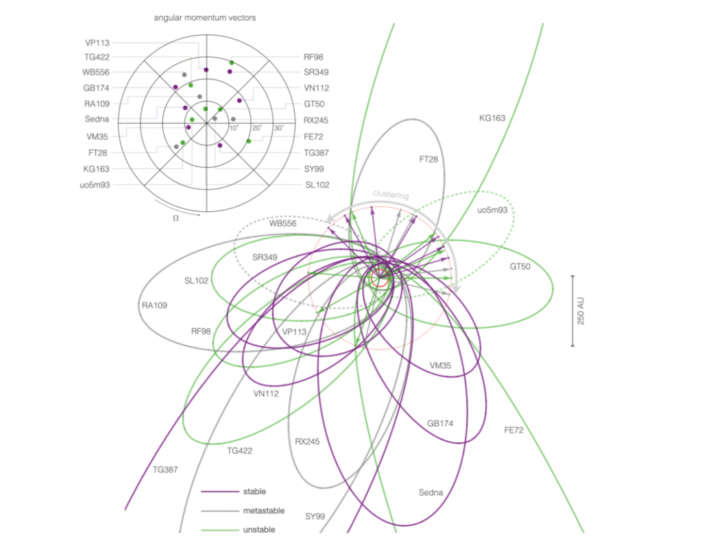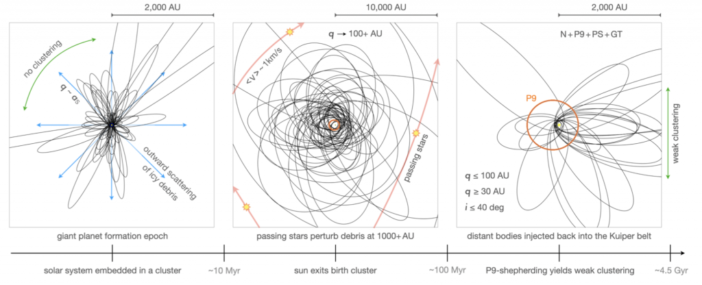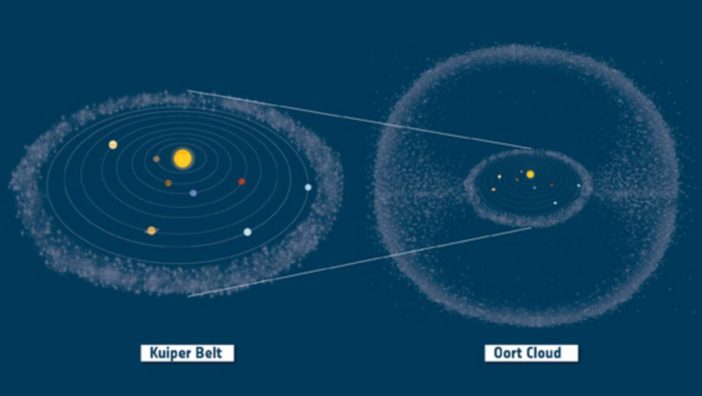Editor’s note: Astrobites is a graduate-student-run organization that digests astrophysical literature for undergraduate students. As part of the partnership between the AAS and astrobites, we occasionally repost astrobites content here at AAS Nova. We hope you enjoy this post from astrobites; the original can be viewed at astrobites.org.
Title: Injection of Inner Oort Cloud Objects Into the Distant Kuiper Belt by Planet Nine
Authors: Konstantin Batygin and Michael E. Brown
First Author’s Institution: California Institute of Technology
Status: Accepted to ApJL
Ladies and gentlemen, welcome aboard the Astrobites Airlines with service from the Earth to Planet Nine. We are currently fourth in line for take-off, but you can learn more about other take-offs to Planet Nine here, here, and here. We are traveling at the speed of light and the duration of our flight will be about 70 hours. We ask that you please enjoy our long journey to the outer solar system.
Our journey starts in the Kuiper Belt, a ring of icy bodies residing beyond Neptune’s orbit. Look around — these are distant Kuiper Belt Objects (KBOs) (look at Figure 1)! We can see (also in Figure 2) two distinct types of distant KBOs: some KBOs have dynamically stable orbits and some do not. Those that are unstable are destabilized by Neptune. The observed clustering of stable orbits needs to be affected by something so that it maintains orbital alignment against differential precession induced by Jupiter, Saturn, Uranus, and Neptune (huge planets that have huge gravity!). So, what is affecting the orbits of the stable KBOs? The authors of today’s paper think it could be Planet Nine!
Figure 2: Census of distant KBOs. The orbits of stable KBOs are depicted in purple and grey. Unstable ones are depicted in green. [Batygin & Brown 2021]
We Forgot That the Universe Is BIG!
The authors have been working on Planet Nine for a long time (their first paper hypothesizing the existence of this distant, unseen giant planet in our solar system was published in 2016)! During this time, they made some estimates on dynamical properties of the planet we are heading to right now. For example, Planet Nine might have a mass of 5 Earth masses, with a semi-major axis of 500 au, an eccentricity of 0.25, and an inclination of 20 degrees from the data that was observed (Planet Nine itself has not yet been observed). However, all this time, the authors treated the solar system as an isolated object, neglecting all the bodies that attain a heliocentric distance of over 10,000 au. But these bodies are still there! The authors’ assumption is valid for representing the evolution of objects with semi-major axes on the order of a few hundred au. More recent detections of trans-Neptunian objects (TNOs), however, increasingly point to a pronounced abundance of long-period TNOs with a heliocentric distance of over 10,000 au. This orbital domain borders the inner Oort cloud (IOC). More importantly, the population of debris in the IOC is stable, just like the KBOs mentioned above! So, the authors’ hypothesis is that some of these stable KBOs were injected into the Kuiper Belt from the outside, possibly due to the influence of Planet Nine.
The Tug-of-War Between Giant Planets and Stars
As we go further and further from the Sun on our spaceship, it is important to note that the Sun’s birth environment played an important role in shaping the solar system. After all, the Sun is the reason we have our solar system in the first place! The Sun, like any other star, was born in a big family of stars — a cluster. Now, it’s time to wear your glasses, because it’s simulation time!
The authors made an N-body simulation of the formation of our solar system including Jupiter and Saturn (they are significant because they are huge) and 100,000 planetesimals, spanning the 4.5−12 au range in the heliocentric distance in initial circular and coplanar orbits. They modeled the Sun’s birth cluster as a Plummer sphere. The Plummer sphere is often used in N-body simulations to “soften” gravity at small distance scales. This is needed to prevent the point particles from scattering too strongly off of one another on a close approach. Along with Jupiter and Saturn, they also modeled “passing stars” — members of the Sun’s family that might have affected the debris gravitationally. All of it, the concurrent growth of giant planets and the passing stars, affects the planetesimals. Think of it as a tug-of-war between Jupiter and Saturn on one side and the passing stars on the other side. Because these icy objects (a.k.a. planetesimals) don’t know where to go, they choose to “freeze” in place, thousands of au away from the Sun. These are what the IOC is formed of.
Have We Reached Planet Nine Yet?
Dear passengers, it’s the time for another simulation! In absence of Planet Nine, the IOC created by the tug-of-war between giant-planet scattering and the passing stars would essentially remain dynamically frozen over the main-sequence lifetime of the Sun. But that’s because Planet Nine wasn’t considered in the first simulation. Let’s see what happens when the authors add Planet Nine.
In this simulation, the authors accounted for the dynamics driven by Neptune, Planet Nine, and the passing stars as well as the effect of the galactic gravitational tidal field and the average effect of Jupiter, Saturn, and Uranus. They found that over the lifetime of the Sun, a significant fraction (that is, on the order of 20%) of the IOC gets injected into the distant Kuiper belt. The authors also found that these re-injected IOC objects exhibit orbital clustering, which is important for the Planet Nine hypothesis (see this previous bite for more details). However, the degree of clustering is considerably weaker. The data suggests that Planet Nine might be even more eccentric than we thought. So, our journey might take a little longer! Another key result of the simulation is that IOC objects display a very extended semi-major axis distribution, which might explain objects like the Goblin.

Figure 3: Sequence of events modeled within this work. A population of trans-Neptunian objects forms while the Sun is still in its birth cluster. Subsequently, over the billion-year lifetime of the solar system, Planet Nine slowly affects these extremely long-period objects, mixing them into the observed census of Kuiper belt objects. [Batygin & Brown 2021]
We are happy that you chose us again for your journey. We are really excited to see what is really out there, far away in our solar system. Thank you for choosing Astrobites Airlines!
Original astrobite edited by Catherine Manea.
A Russian translation of this article is available on Astrobites, also written by Sabina Sagynbayeva.
About the author, Sabina Sagynbayeva:
I’m a graduate student at Stony Brook University and my main research area is planets. I’m currently working on planet formation using hydrodynamical simulations. I’m mainly interested in planet-disk interaction but nearly any topic related to planets is fascinating to me! In addition to doing research, I’m also a singer-songwriter. I LOVE writing songs, and you can find them on any streaming platforms.

